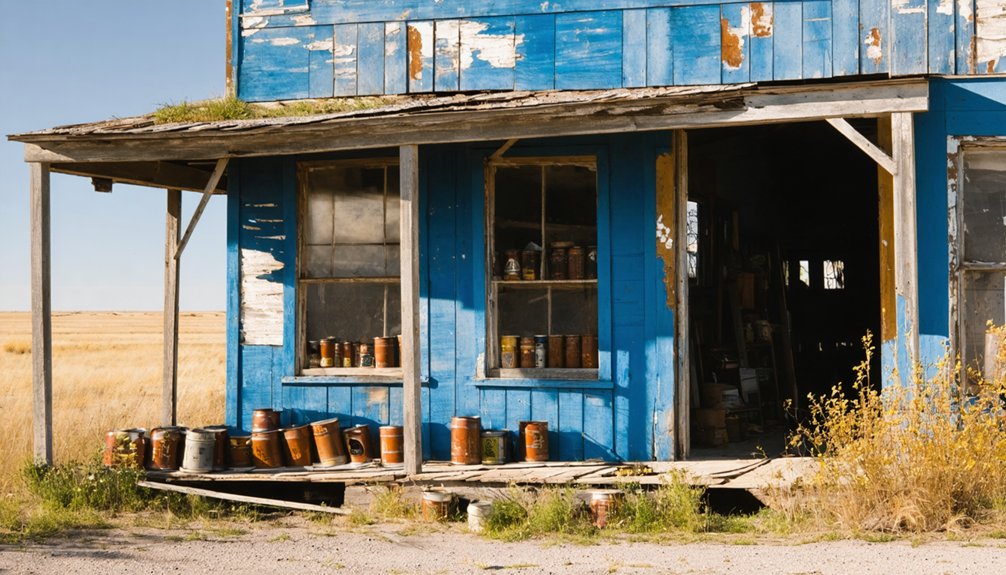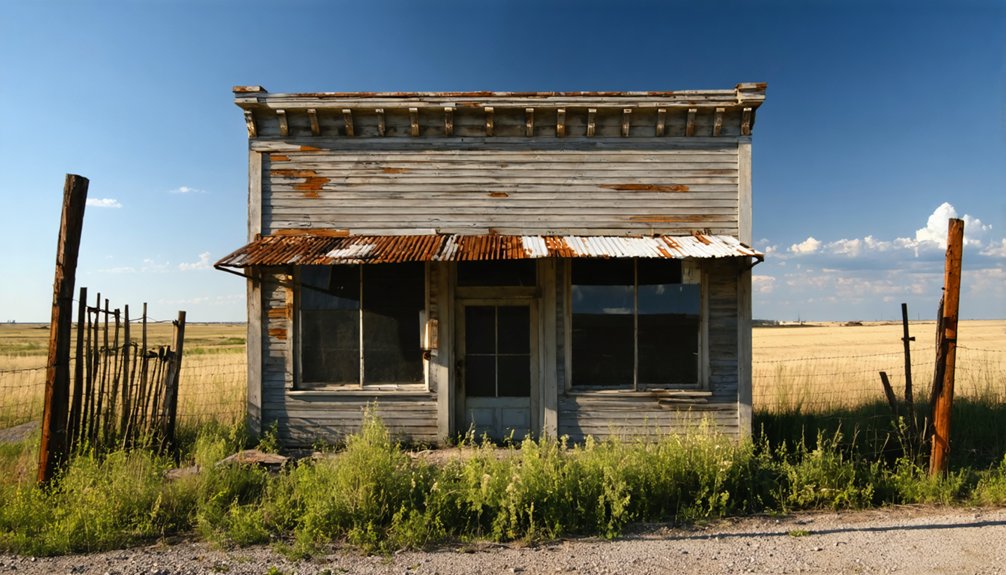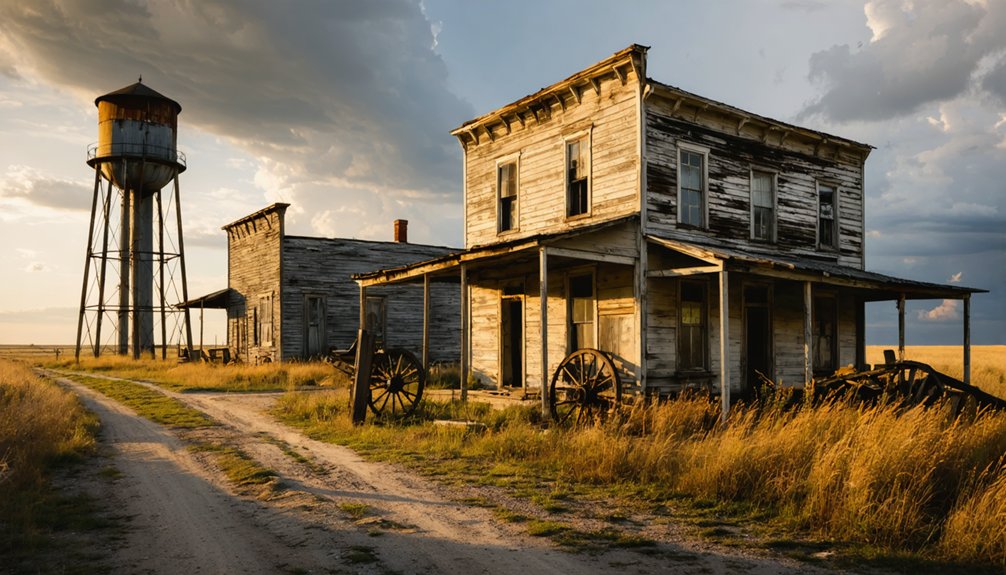You’ll find Hill Side nestled in South Dakota’s Black Hills region, where it once thrived as a prosperous mining settlement following the 1874 gold discoveries. The town boasted a courthouse, general store, post office, and Victorian-style buildings along its bustling Main Street. While the railroad’s arrival in 1890 initially promised growth, its routing through Belle Fourche ultimately contributed to Hill Side’s demise. Today, abandoned buildings and mine shafts tell a compelling story of boom-and-bust mining ventures.
Key Takeaways
- Hill Side was a thriving Black Hills mining town that emerged after gold discoveries in 1874 but later became abandoned.
- The town featured Victorian-style buildings, including an ornate bank, the Harney Peak Hotel, and numerous commercial establishments along Main Street.
- Railroad officials’ decision to route tracks through Belle Fourche in 1890 contributed significantly to Hill Side’s rapid decline and abandonment.
- Today, Hill Side’s ruins include abandoned buildings, mine shafts, and ore bins, serving as remnants of its mining heritage.
- The ghost town is one of over 600 in the Black Hills region, with interpretive trails and signage documenting its history.
The Lost Settlement of Butte County
When you explore Minnesela’s history, you’ll discover a once-thriving county seat that boasted a courthouse, general store, and post office.
Similar to ghost towns like Galena, which thrived during the mining boom, the settlement grew rapidly, establishing two local newspapers to serve its bustling community.
However, the town’s destiny changed dramatically in 1890 when railroad officials chose to route tracks through Belle Fourche instead. This pivotal decision sealed Minnesela’s ghost town legacy, leading to its rapid abandonment.
Geographic Setting and Natural Features
You’ll find Hill Side nestled within the rugged terrain of South Dakota’s Black Hills region, surrounded by thick conifer forests and granite peaks that characterize this historic mining area.
The ghost town‘s setting features varying elevations typical of the Black Hills landscape, with natural creek valleys that once provided essential water resources for early mining operations. Located just 30 miles from Hill City, South Dakota, the ghost town shares similar geographical characteristics with its more populated neighbor. Like many of the defunct mining towns in the area, Hill Side’s remnants tell the story of its rise and fall.
The location’s proximity to landmarks like Mount Rushmore and Custer State Park places it firmly within the mineral-rich mountainous zone that attracted countless prospectors during the region’s mining boom.
Terrain and Local Landscape
Located within the rugged Black Hills region of South Dakota, Hill Side’s terrain exemplifies the dramatic landscape typical of historic gold mining settlements.
You’ll find elevations ranging from 3,500 to 5,000 feet, with steep hillsides and narrow valleys dotted with rocky outcrops and quartz veins. The area’s terrain stability has been affected by historic mining activity, with tailings and collapsed tunnels reshaping the natural topography. A rutted dirt path leads visitors on a quarter-mile trek from the parking area to the main settlement.
Dense pine forests and mixed hardwoods dominate the landscape, while open meadows showcase the region’s vegetation diversity. Several flatiron outcrops rise dramatically above the tree line, creating distinctive landmarks visible for miles.
Small creeks wind through the hills, though many waterways have been altered by past mining operations. The combination of disturbed earth, seasonal rainfall, and underground tunnels has led to notable ground subsidence, creating a constantly evolving terrain that tells the story of Hill Side’s mining past.
Black Hills Geographic Context
The Black Hills region frames Hill Side’s position within a dramatic geological wonderland, where ancient dome-shaped uplifts rise thousands of feet above the Great Plains.
You’ll find yourself surrounded by the Cheyenne River to the south and Belle Fourche River to the north, with smaller waterways like Rapid Creek cutting through the rugged terrain.
The area’s geological significance stems from its 2.5-billion-year-old Precambrian core, while its ecological diversity flourishes across 1.2 million acres of the Black Hills National Forest.
You’re in a unique ecosystem where dense ponderosa pines dominate the north, and mixed-grass prairie characterizes the south. The dark appearance of these mountains comes from their dense evergreen coverage.
The landscape’s carved by extensive cave systems, including Wind Cave and Jewel Cave, while natural landmarks like Bear Butte stand as evidence to the region’s complex geological history. The area’s dramatic elevation reaches over 7,200 feet at its highest point of Harney Peak.
Life in the Black Hills Mining Era
You’d find mining camps in the Black Hills filled with makeshift tents and crude log cabins, where prospectors endured harsh living conditions while pursuing their dreams of striking gold.
Daily life revolved around backbreaking work in the mines, with miners returning to crowded camps that lacked basic amenities like proper sanitation or reliable water sources. The discovery of gold during Custer’s 1874 expedition had sparked this massive influx of prospectors to the region. By 1875, four thousand settlers had illegally moved into these mining camps despite government restrictions.
In these rough frontier settlements, you’d witness a stark contrast between the wealth being extracted from the earth and the primitive conditions most miners called home.
Mining Camp Daily Life
Life in Black Hills mining camps during the boom era was marked by grueling labor and harsh living conditions. You’d spend 10-12 hours underground, earning about $1 per hour while facing constant dangers from cave-ins and poor ventilation.
Your daily routines centered around survival, with entire families crammed into small homes or tents. Social interactions often revolved around saloons and dance halls, where you’d find temporary escape from the brutal work.
You’d likely turn to heavy drinking to cope with the demanding conditions. Despite the hardships, mining communities forged strong bonds through shared struggles.
Your family’s survival depended on everyone contributing – women managed households, children worked early, and miners sometimes resorted to hi-grading just to afford basic necessities like boots.
Rough Frontier Living Conditions
Beyond the daily mining grind, frontier conditions in Black Hills mining camps tested every aspect of survival.
You’d face harsh living hardships in primitive shelters – tents and rough-hewn cabins that offered minimal protection from brutal winters and scorching summers. Water scarcity plagued these settlements, forcing you to compete for limited resources needed for both survival and mining operations.
The lack of proper sanitation issues meant waste disposal was crude, spreading disease through camps like wildfire.
Your diet would consist mainly of preserved foods, with fresh supplies commanding premium prices due to lengthy supply chains. The air you’d breathe would be thick with mining dust, while mercury and cyanide from gold processing contaminated local water sources.
These environmental hazards, combined with poor nutrition and inadequate healthcare, made frontier life a constant struggle.
Community Development and Daily Living
While Hill City began as a modest log-cabin settlement in 1876, it rapidly transformed into a bustling mining town of 3,000 residents by 1890.
The town’s social dynamics revolved around mining schedules, with community cohesion challenged by the transient nature of its workforce. You’d find the heart of daily life centered between two prominent churches that bookended what locals called “a mile of Hell” – a stretch of saloons and commercial establishments along Main Street.
- Victorian-style buildings, including an ornate bank and the Harney Peak Hotel, showcased the town’s prosperity.
- Railroad arrival in 1890 enabled steady supply of goods and connected the community to the outside world.
- Post office and various merchants provided essential services, though the town relied heavily on imported supplies.
Economic Rise and Decline

As French Creek’s placer gold discoveries in 1874 drew prospectors to the Black Hills region, Hill Side emerged during the broader mining settlement wave that transformed the territory.
You’d have found early economic opportunities centered on mining claims and basic commerce supporting the influx of fortune seekers.
Like many Black Hills settlements, Hill Side’s prosperity hinged on two critical factors: mineral wealth and transportation access.
While hard rock mining operations provided initial growth, the town’s long-term survival depended heavily on railroad connectivity.
Mining challenges, including ore depletion and market volatility, eventually took their toll.
Without substantial economic diversification beyond extraction industries, Hill Side remained vulnerable to the boom-and-bust cycles that plagued similar mining communities, ultimately leading to its decline and abandonment.
Abandonment and Historical Impact
Once Hill Side’s mining fortunes dwindled in the late 19th century, the town’s population rapidly declined as residents sought opportunities elsewhere.
Economic shifts and the closure of mines led to a domino effect of business failures. You’ll find that the town’s social fabric unraveled as schools, churches, and gathering places shut down, leading to social isolation for those who remained.
- Abandoned buildings, mine shafts, and ore bins stand as silent witnesses to the town’s mining heritage.
- Environmental damage from mining operations, including tailings and waste piles, still marks the landscape.
- The site now serves as one of over 600 ghost towns in the Black Hills, preserving tangible connections to frontier life.
Today, Hill Side’s ruins tell a compelling story of boom-and-bust cycles that shaped South Dakota’s mining communities.
Preserving Hill Side’s Memory

The preservation of Hill Side’s history remains a multifaceted endeavor spanning archival work, physical conservation, and public education. You’ll find historical societies and state archives working diligently to maintain records, photographs, and artifacts through memory preservation initiatives and digitization projects.
They’re capturing oral histories from descendants while protecting the site’s physical remnants through strategic conservation efforts.
When you explore Hill Side today, you’ll notice interpretive trails and signage that tell its story, while controlled archaeological excavations document what lies beneath.
Local museums showcase exhibits that put the town’s role in regional history into context. Through partnerships between government agencies, historical societies, and Native American tribes, historical documentation efforts continue to guarantee Hill Side’s legacy endures for future generations to discover and understand.
Frequently Asked Questions
Were Any Notable Crimes or Lawlessness Reported in Hill Side?
You won’t find documented criminal activities or law enforcement records specific to Hill Side in historical archives, though the town likely faced typical frontier challenges like other Black Hills mining communities.
Did Native American Tribes Have Any Significant Interaction With Hill Side Settlers?
While records show over 50,000 Native Americans lived in the Black Hills region, you’ll find limited evidence of cultural exchange between Hill Side settlers and tribes, beyond occasional land disputes during settlement.
What Happened to the Personal Belongings Left Behind by Residents?
You’ll find most abandoned artifacts scattered or destroyed by weather, vandalism, and scavenging. Lost memories include personal items that decayed naturally or were taken by visitors over time.
Were There Any Attempts to Revive or Resettle Hill Side?
You’ll find that revival efforts were mainly tied to mining booms, with major attempts in 1887 by Harney Peak Tin Mining Company. Later settlement challenges led to tourism-focused developments, though none matched the original population.
Did Hill Side Have Any Unique Local Customs or Celebrations?
You’ll find limited records of Hill Side’s specific local traditions, but mining celebrations and holiday festivities likely mirrored nearby Black Hills towns, with saloon gatherings, church events, and miners’ victory feasts.
References
- https://www.sdpb.org/rural-life-and-history/2023-08-21/some-black-hills-ghost-towns-and-their-origins
- https://www.sdhspress.com/journal/south-dakota-history-2-2/some-black-hills-ghost-towns-and-their-origins/vol-02-no-2-some-black-hills-ghost-towns-and-their-origins.pdf
- https://westernmininghistory.com/towns/south-dakota/hill-city/
- https://en.wikipedia.org/wiki/Hill_City
- https://koa.com/campgrounds/hill-city/blog/the-history-of-hill-city-south-dakota_d2f2a510-44d2-4e37-80e2-e58db6751b04/
- https://www.youtube.com/watch?v=Glucs_Rq8Xs
- https://en.wikipedia.org/wiki/List_of_ghost_towns_in_South_Dakota
- https://www.youtube.com/watch?v=_0WNYsFLSLA
- https://www.southdakotamagazine.com/galenas-ghosts
- https://en.wikipedia.org/wiki/Minnesela



